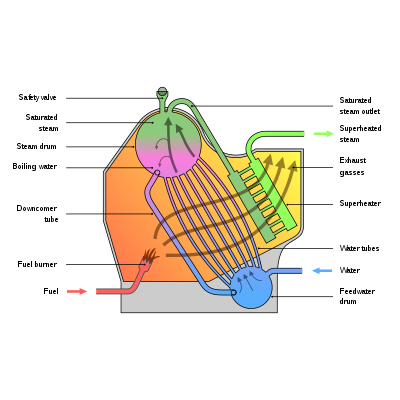
Back غلاية أنابيب المياه Arabic Водотръбен котел Bulgarian Wasserrohrkessel German Caldera de tubos de agua Spanish دیگ بخار لولهآبی Persian Vesiputkikattila Finnish Chaudière à tubes d'eau French Vodocijevni kotao Croatian Caldaia a tubi d'acqua Italian Dandang tiub air Malay

A high pressure watertube boiler[1] (also spelled water-tube and water tube) is a type of boiler in which water circulates in tubes heated externally by fire. Fuel is burned inside the furnace, creating hot gas which boils water in the steam-generating tubes. In smaller boilers, additional generating tubes are separate in the furnace, while larger utility boilers rely on the water-filled tubes that make up the walls of the furnace to generate steam.
The heated water/steam mixture then rises into the steam drum. Here, saturated steam is drawn off the top of the drum. In some[which?] services, the steam passes through tubes in the hot gas path, (a superheater) to become superheated. Superheated steam is a dry gas and therefore is typically used to drive turbines, since water droplets can severely damage turbine blades.
Saturated water at the bottom of the steam drum returns to the lower drum via large-bore 'downcomer tubes', where it pre-heats the feedwater supply. (In large utility boilers, the feedwater is supplied to the steam drum and the downcomers supply water to the bottom of the waterwalls). To increase economy of the boiler, exhaust gases are also used to pre-heat combustion air blown into the burners, and to warm the feedwater supply in an economizer. Such watertube boilers in thermal power stations are also called steam generating units.
The older fire-tube boiler design, in which the water surrounds the heat source and gases from combustion pass through tubes within the water space, is typically a much weaker structure and is rarely used for pressures above 2.4 MPa (350 psi). A significant advantage of the watertube boiler is that there is less chance of a catastrophic failure: there is not a large volume of water in the boiler nor are there large mechanical elements subject to failure.
A water-tube boiler was patented by Blakey of England in 1766 and was made by Dallery of France in 1780.[2]
- ^ "Recommended Guidelines for the Care of Power Boilers" (PDF). Archived from the original (PDF) on 2016-10-11. Retrieved 2013-11-21.
- ^ Marshall, Chapman Frederick (16 December 2014). A History of Railway Locomotives down to the End of the Year 1831. BoD – Books on Demand. ISBN 9783845712871 – via Google Books.